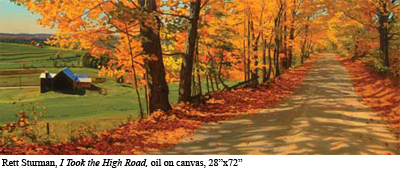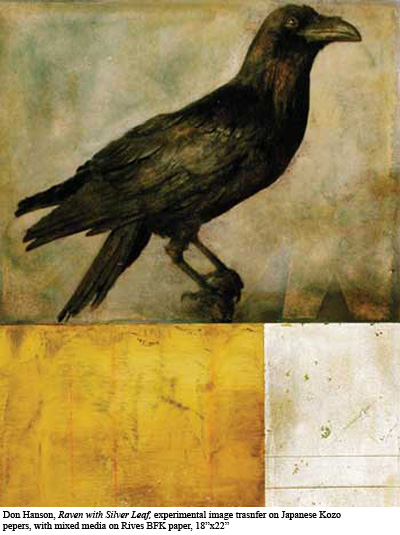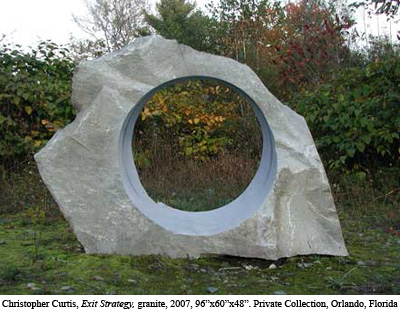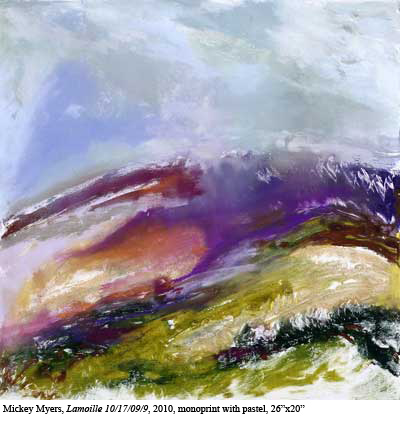Five from Stowe
Select talent from this mountain village
By Marc Awodey
Located at the foot of Vermont’s tallest mountain, Mt. Mansfield, the picturesque village of Stowe is a popular destination for both skiing in winter and fly fishing in summer. It’s also a hotbed of visual art year-round. From the hundreds of artists hailing from Stowe and its environs, the Art New England staff, with help from a few Vermont writers and artists, arrived at a group of five individuals who seem indicative of the caliber of visual art around Stowe. These brief profiles illustrate why Stowe is one of the most vibrant small art towns in America.
Rett Sturman

Painter Rett Sturman lives just over the Stowe town line in an area colloquially known as Mud City, yet there’s nothing muddy about his view of Vermont. Ever since the days of the Hudson River School, when Sanford Robinson Gifford trekked to Lamoille County to paint an idealized view of Mt. Mansfield, landscapes have been an artistic staple of the Green Mountain State. Sturman’s are among the very best. Crisp portrayals of light dominate his beautifully composed realist works. His canvasses are as precise as photorealism, yet unaided by any mechanical tricks.
I Took the High Road is a panoramic horizontal composition, capturing a rural dirt road ascending toward the right, through rows of orange-leafed deciduous trees. A distant farm appears at lower left, and a vista of green fields unfolds toward a hilly horizon. Sturman’s aims are modest: “I am very interested in what I see. Certain things become magical because of the light, and I feel compelled to try to put them down.” Many examples of his masterful yet unpretentious art are found at www.rettsturman.com.
Nancy Dwyer

You won’t often find Nancy Dwyer’s work in Vermont but it has appeared at the Whitney Museum of American Art, the Metropolitan Museum of Art, the New Museum of Contemporary Art in New York City, MOCA, Los Angeles, and internationally at various major museums and galleries. Although she has shown at Burlington’s Firehouse Gallery, plenty of Vermont artists, especially in academia, are more closely connected to the wider art world than the local scene. With only about 600,000 people in the entire state, there just isn’t the critical mass of venues to be found along the East Coast.
While Dwyer lives in Stowe, her aesthetic is certainly big city. Styrofoam, for example, is among her materials. Dwyer teaches at the University of Vermont and since the 1970s has used words within her works. In a recent interview, she staid, “I thought of titles and then looked for images to go with them. Then I realized the images were vestigial.” With a pop art sensibility, Dwyer’s sculpted words became images. A range of her paintings and sculpture can be found at www.nancydwyer.com.
Don Hanson

Printmaker and painter Don Hanson also lives in Stowe, but his mixed-media works are more closely related to the natural world than Dwyer’s. Hanson is a brilliant technician and his pieces are sometimes marked by delicacy and an air of transience. Insects, primitive figuration, and completely nonobjective images appear among his subjects. His pieces often seem dark and moody at first, yet inevitably a glimmer of hope and light becomes a subtext.
Hanson’s The Avian Series: Damaged Beauty is a group of twenty-five mixed-media monoprints with photo transfers, based on specimens from the taxidermy collection at the Fairbanks Museum in St. Johnsbury, Vermont. While form and line are crucial, the narrative context of his images may be paramount. Hanson’s iconic “Elk” series presents images reminiscent of Neolithic cave art, restated in twenty-one small monochromatic paintings. Visit www.donhansonart.com for an excellent selection of Hanson’s works.
Christopher Curtis

West Branch Gallery and Sculpture Park, on the Mountain Road in Stowe, was founded by Tari Swenson and her husband Christopher Curtis. Both are artists. Curtis curates the spacious sculpture park and has completed major large-scale commissions in various parts of the country.
Curtis often uses Barre granite from central Vermont, and feels a deep connection to nature. “My hope is that these sculptures not only promote awareness and appreciation of the natural environment, but encourage reflection about how best to manage, preserve, and use our shared global resources.” Many of his pieces are megaliths juxtaposing straight lines with natural forms. His piece called Exit Strategy, commissioned for a site in Ocala, Florida, has a perfect five-foot diameter circle of negative space sliced into a large, broad ring of granite. An image of it appears with other pieces at www.christophercurtis.com. In addition to large-scale outdoor pieces, Curtis creates graceful interior stone sculptures that often seem paradoxically light.
Mickey Myers

The rich yet ethereal mixed-media monoprints of Mickey Myers are influenced by Helen Frankenthaler, Jennifer Bartlett, J.M.W. Turner, and Emily Mason, among others. Landscape is a departure point for Myers, and her destination is pure color.
“The Seasons” is a series of sixteen thirty-by-sixteen-inch vertically oriented portraits of the sky as it changes from the greens and blues of spring, through majestic purples, reds, and greens in summer, into fiery hues of autumn and the silvery grays of winter. “It’s what the landscape is all about: the sunlight versus the shadow, the mountaintop versus the clouds. In winter, it’s the hardness of the evergreen trees versus the softness of the snow; in summer, the intensity of the colors of the foliage versus the light that is bouncing off the surface of a tree or rock.” The monoprints are usually reworked with pastel, broadening Myers’s range of visual textures.
Another recent series, “The Lamoille Project,” is a collection of 140 monoprints commissioned for the Print Club of Madison, Wisconsin. The two-year project was circulated to the Print Club’s 120 members, plus contributed to the Madison Museum of Contemporary Art.
Myers is the former director of Stowe’s Helen Day Art Center, and currently the director of the Mary Brian Memorial Gallery in nearby Jeffersonville. Eighty-five of the prolific Myers’s pieces appear on her web site at www.mickeymyers.com.
__________________________________________________________________________________________
Marc Awodey teaches fine arts at Johnson State College and Burlington College, and is a regular contributor to Art New England and the alternative weekly Seven Days.
